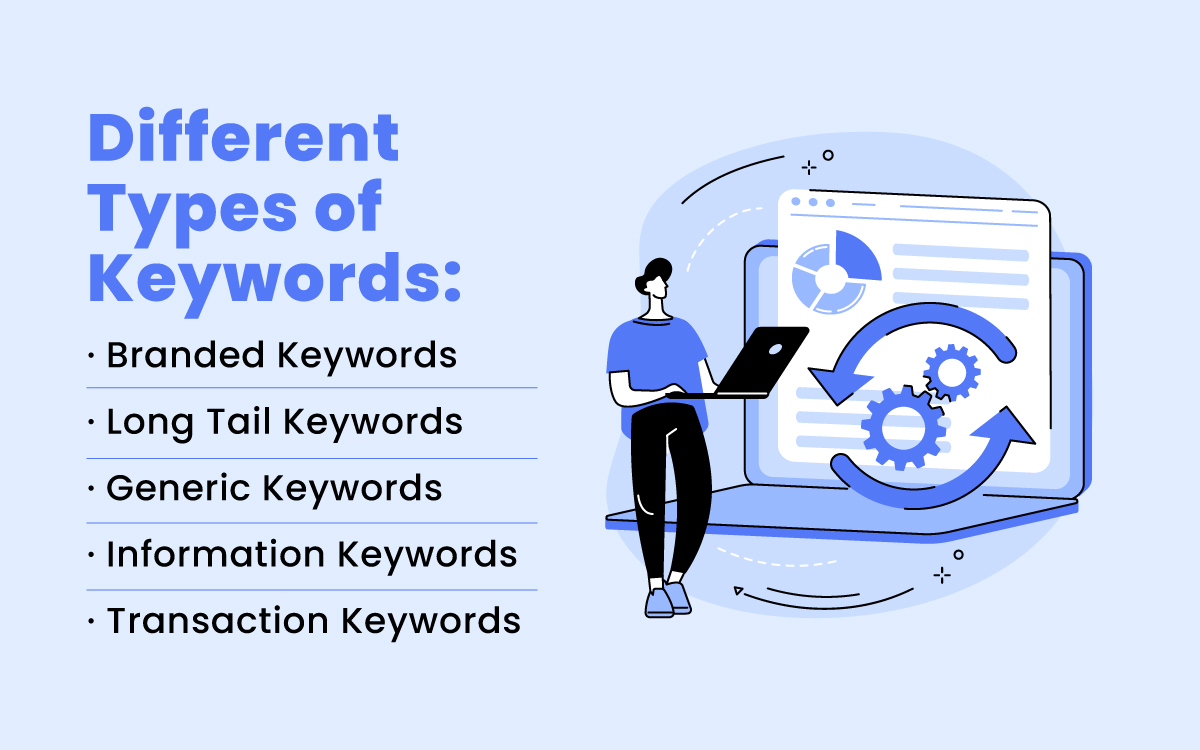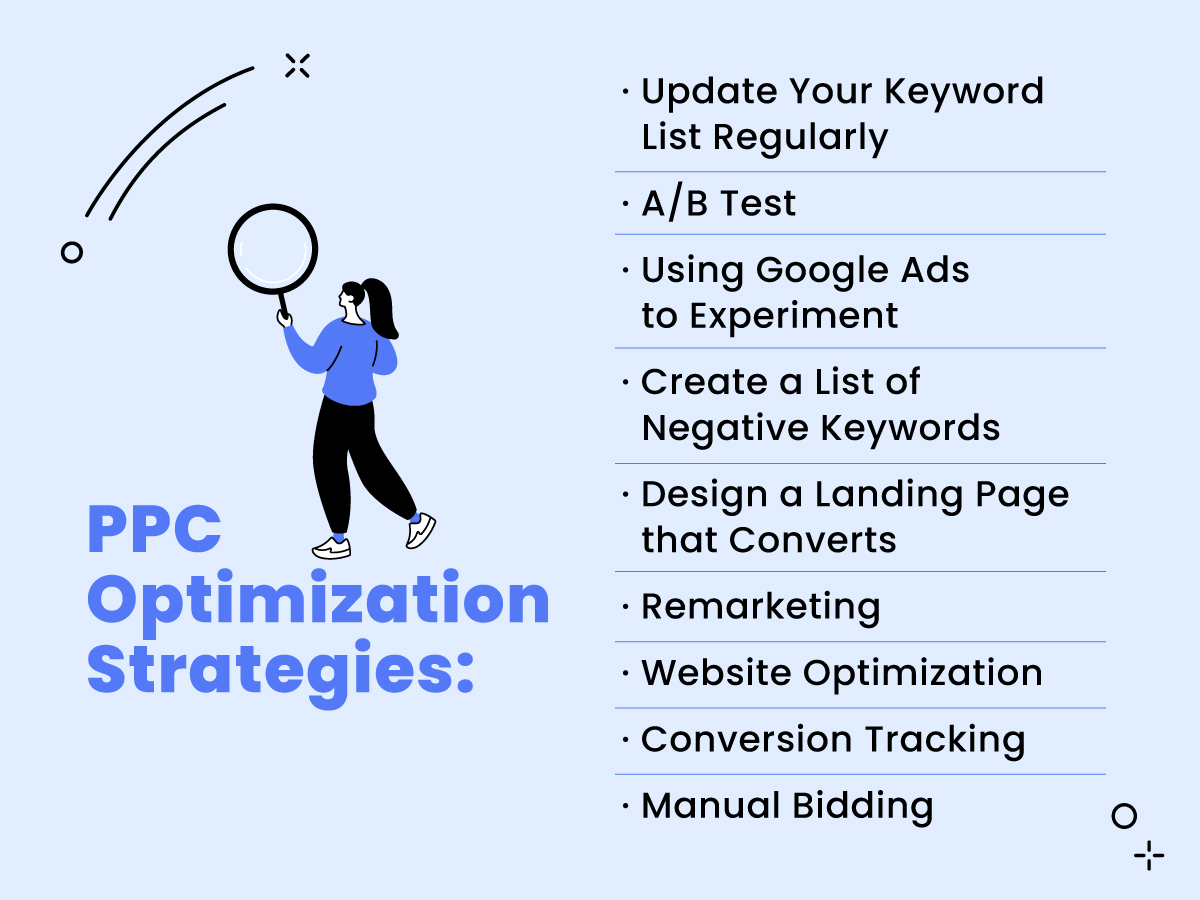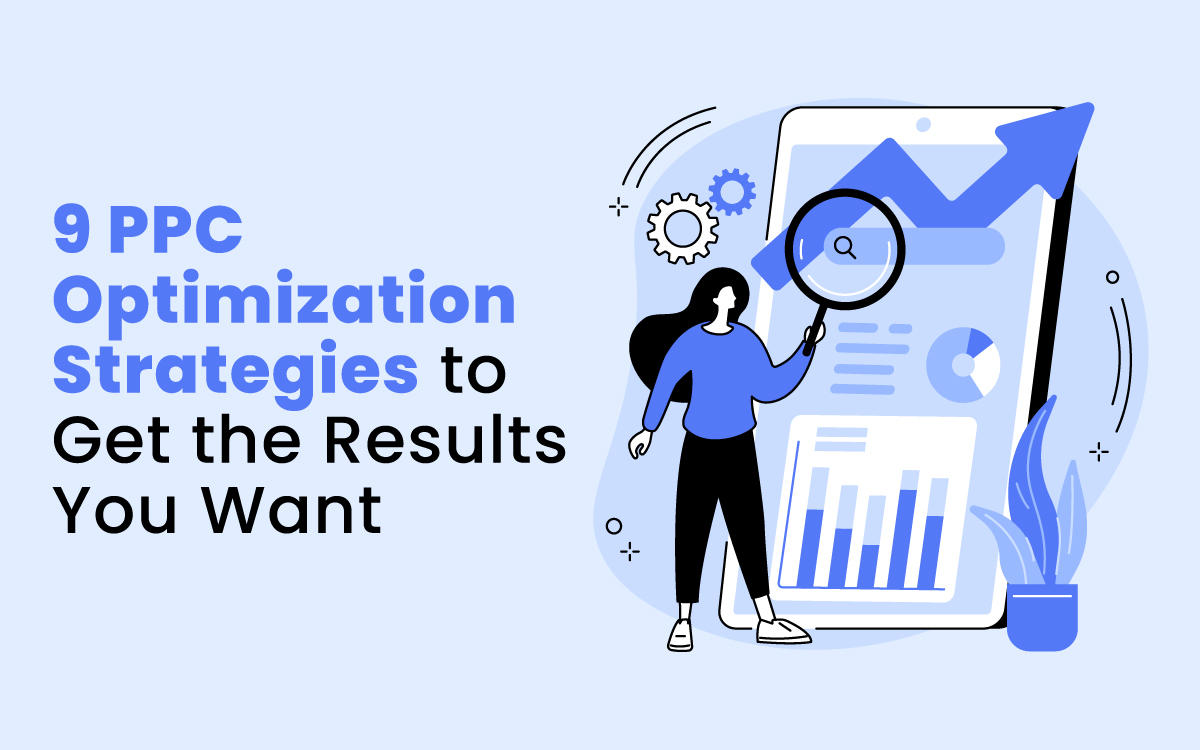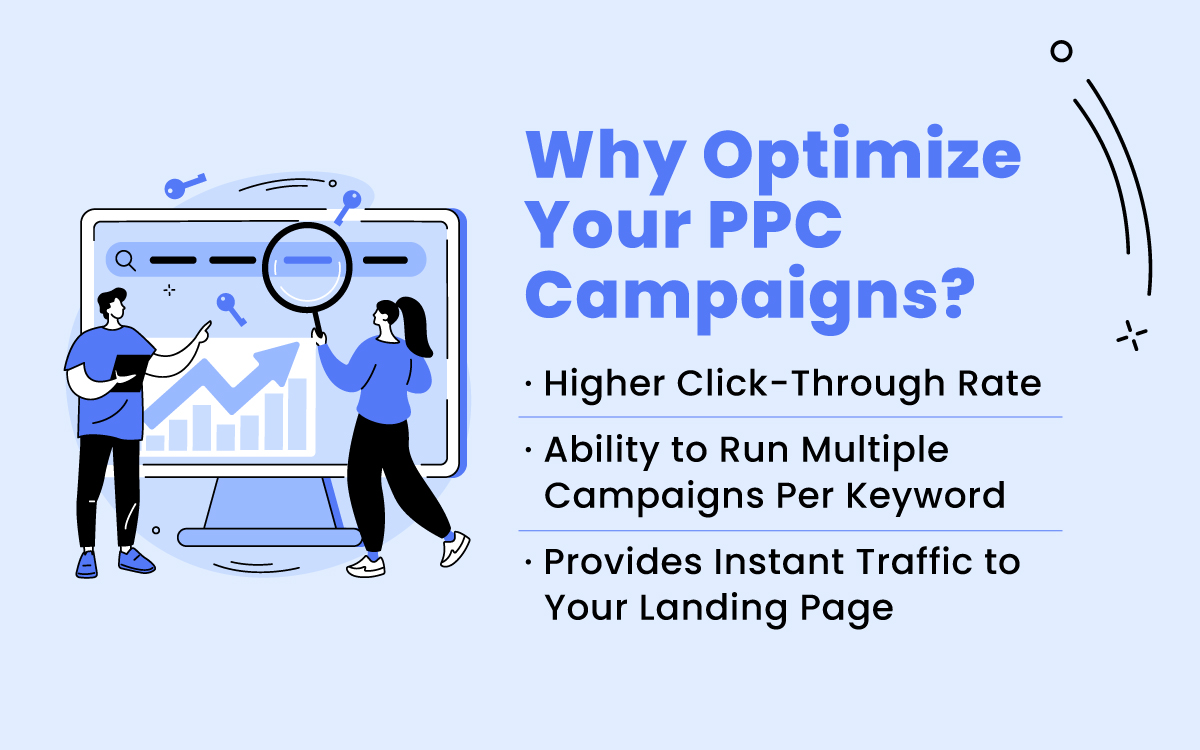If you’ve been looking for ways to optimize your business, then it’s likely you’ve heard about “PPC Optimization.” Reaching a target audience is challenging at times. While attention-grabbing headlines help get more clicks in the search results, your campaign performance depends on more than eye-catching copy.
Implementing a top-performing PPC campaign strategy not only improves the success of your paid ads. A well-executed PPC campaign has the potential to boost sales and improve conversion rates by driving traffic and increasing your return on investment.
Using tools like Google Analytics can help you decipher the impact of your ad campaigns. However, to take your ad campaigns to the next level, it’s crucial to incorporate optimization strategies. Here’s everything you need to know about how to optimize your PPC campaigns.
An Intro to PPC
PPC, or pay-per-click, is a digital marketing strategy often used to increase leads and help your sales funnel become more effective. When experts talk about PPC campaigns or PPC optimization, they’re often referring to the method of acquisition that involves paying for web traffic. This is often done by utilizing specific keywords and leveraging PPC bids – a common way to place bids in a pay-per-click auction to improve the chances of being at the top of the search results.
While there are various ways to create a digital marketing strategy that increases sales, PPC campaigns tend to have a higher success rate because they guarantee greater results upfront. Whereas SEO may take some time to achieve the same results.
What Is PPC Optimization?
Optimizing your PPC campaigns simply means spending time analyzing meaningful data so that you can extend your reach and improve your paid search results. The main goal when you want to optimize your PPC campaign is to increase visibility while finding the best way to stay within the campaign budget. Marketers usually optimize their campaigns by updating landing pages, changing ad copy, or performing bid adjustments.
Essentially, PPC optimization focuses on targeting keyword bids that increase CTRs and boost your return on investment (ROI). Choosing the right keywords maximizes clicks and lowers the cost that you pay-per-click. PPC advertising is one of the most commonly used techniques by B2B marketers as it’s become one of the top channels for lead generation.
PPC Optimization Helps Marketers:
- Generate quality leads
- Maximize conversion value
- Leverage the power of digital marketing strategies to get your products in front of the right buyer
Why Optimize Your PPC Campaigns?
Optimizing your PPC campaigns come with several perks. Here are a few:
Higher Click-Through-Rate
Click-through rates (CTR) are important because they indicate the number of clicks you’ll receive to your ad (or ads) per number of impressions. PPC ads thrive on CTRs. The higher the number of CTRs, the more your quality score will be affected and therefore dictate how much you will pay for each click based on the Google Ads Algorithm.
Ability to Run Multiple Campaigns Per Keyword
To maximize your PPC performance and get the most value for your ad budget, running multiple campaigns per new keyword is a good way to increase sales and improve your paid search strategy. Being able to run more than one campaign at a time helps you tap potential lead sources and save you a lot of time.
Provides Instant Traffic to Your Landing Page
Landing pages are key to personalizing your customers’ experiences and turning a click into a lead and not a bounce to other sites. This is something that a well-executed PPC campaign can help you accomplish, as it increases visibility and brand awareness so that your target audience goes straight to your site.
The Importance of Keywords on PPC Ads
Keywords are what hold the success of your PPC campaign performance. When it comes to a PPC ad, keyword research is crucial. That’s because keyword bids are what attract customers to your site.
There are different types of keywords in PPC advertising. The following are the types of keywords you should implement in your PPC ads to maximize the optimization process.
- Branded Keywords – Branded keywords refer to the name of the company. For example, “Trader Joe’s” or “Wendy’s.”
- Long Tail Keywords – These types of keywords are the ones that will help customers find specific products or services. As the name suggests, these types of keywords are typically on the longer side, usually with four or more words within a phrase. For example, “red, pre-owned dress for evening wear.”
- Generic Keywords – These are keywords that are common search terms, like: “supermarket,” or “car dealership.”
- Informational Keywords – Think of these keywords as the ones that lead customers to learn more about a product or service. For example, “reviews” or “top-rated.”
- Transactional Keywords – These are common search terms for the purchasing of a product or service. Think of keywords like “buy” or “sale.”
By using a combination of these types of keywords, you’re maximizing your bidding strategy and increasing the likelihood of successful PPC optimization.

Other Types of Keywords
Not every keyword is the right keyword for your PPC ad. There are times when certain keywords work against you and prevent your PPC ads from being successful.
Remember, the main reason behind incorporating specific keywords into your ad copy is to extend your reach to key audiences. To do this, you have to make sure that your keyword list includes keywords that will attract the right kind of viewers to your landing page. Moreover, the keywords you choose dictate what you are aiming to rank for.
This is the part where you need to be careful. Incorporating low-performing keywords or non-performing keywords deters your target audience from ever seeing your ad and having enough impact to boost sales. They’re called Negative Keywords. This is what they mean.
Negative Keywords
Negative keywords are the words that drive the wrong kind of traffic to your landing page. Essentially, these are customers that navigate to landing pages with products they’re not interested in. And because they’re being directed to a landing page that’s not beneficial to them, they’re that much more likely to bounce to other sites in search of what they’re truly looking for.
What makes this whole scenario worse is that you’re still paying per click even though you didn’t make a conversion. This, in turn, makes you waste ad spend on unqualified clicks and prevents your campaign from being correctly targeted.
To avoid situations like this in which your entire digital marketing strategy is affected, the best thing to do is to create a negative keyword list. Creating a list like this helps you differentiate between the right keywords and the keywords that are detrimental to your PPC ads. Any word that has a low search volume or is not relevant to what you’re trying to sell on your landing page has no place in your PPC campaign.
For example, let’s say that your landing page is advertising vintage cars. That means that the ad copy should not include keywords like “new cars” or “zero miles.” Keywords such as these will make the entire ad copy misleading and attract the wrong customers to your landing page. In other words, by avoiding negative keywords, you’re putting a stop to irrelevant search queries and saving pennies on your ad budget.

PPC Optimization Strategies
The main purpose of your landing page is to bring customers to a digital space that contains everything they’re looking for. To do this, page elements must be arranged in a certain order, ad copy must be tidy and to the point, and above all, everything on your landing page must be functional. Here are some strategies to keep in mind for maximum optimization.
Update Your Keyword List Regularly
PPC advertising relies on specific keywords that help you rank higher on search pages. However, remember that the Internet is an ever-changing place. It’s important to perform constant monitoring of your keywords so that you can measure their efficiency and overall performance.
A single keyword incurs a cost for you on your ads. Successful landing pages have a constant flow of top-performing keywords so that campaign budgets are not jeopardized by low-performing keywords. Track the keywords that are working and get rid of those that are not.
For a more targeted reach, try including localized keywords that set your product or service apart from general searches. For example, instead of saying “Fresh Bread,” try including something like “Fresh Bread in New York.”
A/B Test Your Ad Campaign
One key element to a successful campaign, whether through Google ads or otherwise, is for all the elements that make up the campaign to work correctly. As a marketer, you need to make sure that all the page elements on your landing pages work, like call-to-action buttons, designs, and headlines.
Call-to-action buttons are particularly important as they’re the drivers of your conversion. Every detail matters. Remember, you’re trying to figure out what works best to attract your desired customer.
Something that you can do to gauge the effectiveness of what’s on your page is to create multiple versions of your landing pages to test out different factors and see what works best. This is a good way to make sure every element on the page functions correctly and test variations on the page that will help you determine what performs best. At the end of your testing period, you’ll have a better idea of how to move forward so that your PPC campaign can achieve the most success.
Using Google Ads to Experiment
This is an area that’s super easy to experiment with through Google ads. In Google ads, users can easily navigate to their Experiments Tab and play around on their various linked landing pages to see what’s working.
Design a Landing Page that Converts
Because your landing page is where customers go to learn more about your product or service, it’s key for your landing page to be optimized enough to positively affect your conversion rates. Make sure to feature the following information.
- Attention-grabbing pictures or graphics of the product. The goal here is to highlight your product as much as possible without overwhelming your potential customer. If they clicked on your ad, it’s because they want to know more. This is your chance to wow them.
- Be transparent about the pricing of your product. Nobody likes surprises when it comes to spending. The cost of your product is a deciding factor for customers tiptoeing around their decision. Don’t be afraid to showcase your product’s worth. This is a good way for the customer to figure out on their own if what you’re offering fits their budget.
- Include enough information about your product for your customer to understand what they’re buying. Remember, your customer is on a journey. They may have had a hard time finding what they need and you’re there to offer it to them. Make sure to include a detailed description of what your product does, what it’s made of, and other important factors that you feel your target audience should know.
- Don’t forget to include a powerful call to action. No matter what you’re selling or offering, it’s critical to entice a customer to either make a purchase or request more information. Don’t underestimate the power of a few words on a button. A simple “add to cart” or “buy now” works wonders.
Leverage Remarketing or Retargeting
It’s rare to see high conversion rates from customers visiting your page for the first time. Yet, that doesn’t mean your ad or ads aren’t working. It simply means that you need to implement a little remarketing to boost the success of your ad or ads.
WHAT IS REMARKETING?
It’s a term that refers to connecting your product or service with people that have previously been exposed to, clicked on, or seen your ad/ads. It’s a way to re-engage customers that didn’t make a purchase the first time.
The process of remarketing involves tracking down any potential clients that have clicked around your ads before and exposing them to new ads advertising your products to them again, but in a shiny, new way.
The most common way of doing this is by creating an ad group (or ad groups depending on the multiple campaigns you may be running) of people that have visited your landing page. Although there are some privacy and security updates in place that will create a little bit of a hurdle, remarketing is still very much in use today and a proven way to improve conversation rates.
Optimize Your Website
Optimizing your website is the equivalent of a first impression. If you’re doing all this work towards driving a target audience to click on your ad campaigns, it only makes sense that your website is up-to-date and can offer a good experience.
There are particular vitals that you can test your website for to make sure it’s running and that it’s optimized to the max:
- Is your page loading quickly? Loading times should not go past 2.5 seconds.
- Are your page visuals stable? The elements on your page should not distract your customers from reading what’s on your site. Try to keep things eye-catching but simple so that it doesn’t disturb your overall message.
- Does your page have a quick interactivity rate? This refers to how quickly your page responds when a customer clicks around. Fast responses are typically kept under 100 milliseconds.
Monitor Your Conversion Tracking
Conversion tracking is an important aspect of your PPC optimization because it gives you perspective on what’s working through the use of analytics. For example, let’s say you’re looking to increase the number of form completions on your website. By using a tool like Google Tag Manager, you can configure your tags and import those tag goals into Google ads.
Explore Manual Bidding
Manual bidding is the best option for optimizing bids. Although it’s more common to allow Google to help you achieve the highest number of clicks based on the budget you set up, the process comes with some limitations that impact the control you have over your campaigns.
With a manual bidding strategy, you can:
- Increase the visibility of your ads
- Lower your cost per action (CPA)
- Focus on keywords that you know perform better than others
Keep in mind that while manual bidding works wonders, it’s also an advanced strategy that requires some caution and knowledge. It will help you gain control over your bids, but it will also mean you’ll have to spend more time making sure you’re bidding the right amount at the right time.
The Difference Between PPC and SEO
Although similar, SEO and PPC are very different. SEO, or Search Engine Optimization, focuses on increasing organic traffic to your site by optimizing your website and catering it to a specific audience.
On the other hand, PPC focuses more on ads that you pay for and that you’re aiming to get to the top of the page to increase visibility, lead generation, and boost sales. Think of PPC as a gateway to your SEO-optimized site. Both strategies are interrelated but they are different.
Final Takeaway
Implementing PPC optimization takes a lot of work initially. But once your campaigns are increasing conversion rates and getting you in front of the right customers, the whole process will seem very much worth it.
The key thing to remember is that PPC optimization is an ongoing process. It’s not something that you can do once and then forget. It involves time and dedication to paying attention to all the different elements that make your site yours.
Ads are a tricky thing sometimes. Pay close attention to every detail so that it’s designed for the right search. Implementing PPC optimization is a vital step in this process. By following these tips and strategies, you’ll be able to maximize your efforts and improve performance to enjoy better results.



